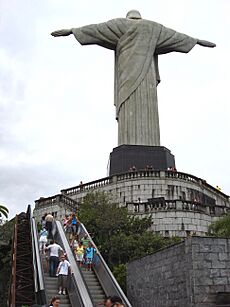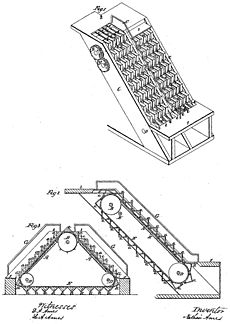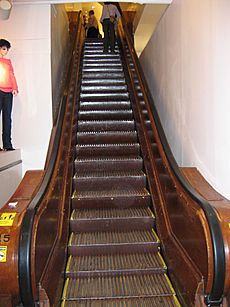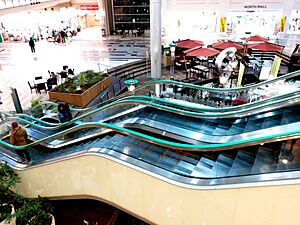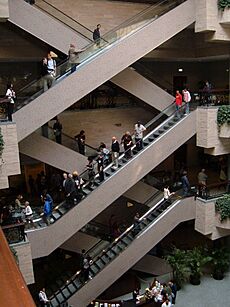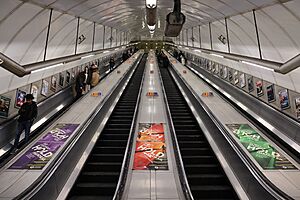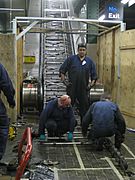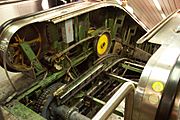Escalator facts for kids

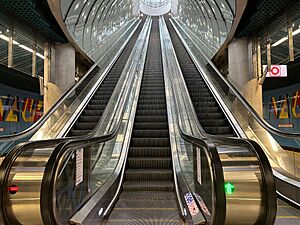
An escalator is like a moving staircase that carries people up or down between different floors of a building. It uses a motor to move a chain of steps that stay flat for you to stand on.
Escalators are used all over the world, especially in busy places where many people need to move quickly. You can find them in department stores, shopping malls, airports, railway stations, and public buildings. They are great because they can move lots of people without much waiting. Even if an escalator stops working, it can still be used as a regular staircase!
Contents
How Escalators Began
Early Ideas and Inventors
The idea for a moving staircase goes back a long time. In 1859, Nathan Ames patented the first "revolving stairs," which was an early idea for an escalator. However, his design was never actually built.
Later, in 1892, Jesse W. Reno patented his "Endless Conveyor or Elevator." He built the first working escalator, which he called an "inclined elevator." It was installed at Coney Island, New York City in 1896. This early escalator was a moving belt with cleats for people to stand on.
Around 1895, Charles Seeberger designed a moving staircase that looked more like the escalators we see today. He worked with the Otis Elevator Company to build the first commercial escalator. This escalator won a top prize at the 1900 Paris Exposition Universelle, a big world's fair.
The Name "Escalator"
Charles Seeberger actually created the word "escalator" in 1900. He combined the Latin word "scala," meaning "steps" or "ladder," with other parts to make the new word. For many years, only the Otis Elevator Company could use the name "escalator" because it was their trademark. But in 1950, a court decided that "escalator" had become a common word for any moving stairway. So, now any company can use the name.
Old Escalators Still Working
Some very old escalators are still in use today! Here are a few examples:
- The St Anna Pedestrian Tunnel in Antwerp, Belgium, opened in 1933.
- The Maastunnel in Rotterdam, The Netherlands, opened in 1942.
- Macy's Herald Square department store in New York City, U.S., has escalators from the 1920s.
How Escalators Are Designed
Escalators are designed to fit different buildings and move people efficiently. Engineers consider how many people will use them, how far they need to travel, and how much space is available.
Most escalators go up at an angle of 30 or 35 degrees. They move at about 1 to 3 feet per second. Modern escalators usually have steps made of aluminum or stainless steel.
There are different ways escalators can be arranged:
- Parallel: Up and down escalators are placed side-by-side. You often see this in metro stations.
- Multiple parallel: Several escalators go in the same direction, next to other escalators going the opposite way.
- Crisscross: Escalators going up are "stacked" with escalators going down, often at right angles to each other. This is common in department stores.
Most escalators have moving handrails that go at the same speed as the steps. This helps riders keep their balance. Sometimes, the direction of an escalator can be changed depending on how many people are going up or down.
Escalator Parts
- Escalator components
Here are the main parts of an escalator:
- Landing Platforms: These are the flat areas at the top and bottom where you step on and off. They contain the motor and gears that move the steps.
- Truss: This is the strong metal frame that supports the entire escalator, connecting the top and bottom landings.
- Balustrade: This is the side part of the escalator that supports the handrails. It can be made of metal, glass, or other materials.
- Handrail: The moving belt that you hold onto. It moves at the same speed as the steps.
- Track System: Inside the truss, there are tracks that guide the wheels of the steps, making them flatten out at the ends and form stairs in the middle.
- Steps: These are the individual moving stairs you stand on. They are usually made of metal and have ridges that fit together like a comb.
Cool Escalator Designs
Some escalators have really unique designs! Mitsubishi Electric has been successful in making spiral or helical escalators since the 1980s. These escalators curve as they go up or down, which looks very cool and can save space. The world's first practical spiral escalator was installed in Osaka, Japan, in 1985.
Staying Safe on Escalators
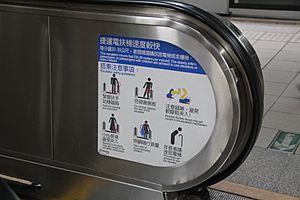
Safety is very important when using escalators. Escalators are powerful machines, and it's important to be careful to avoid accidents.
- Always stand facing forward.
- Hold the handrail.
- Be careful with loose clothing, shoelaces, or bags that could get caught.
- Children should always be supervised by an adult.
- Footwear like Crocs and flip-flops can sometimes get caught more easily due to their soft material. Be extra careful with these shoes.
- Look out for the yellow lines on the steps; they show where the edges are.
- Know where the emergency stop button is, but only use it if there's a real emergency.
Escalators are designed with safety features, but proper maintenance is also key. For example, after a fire at London's King's Cross station in 1987, it was found that debris under the escalators had contributed to the fire. This led to important safety changes, like removing old wooden escalators and making sure all parts of the London Underground were smoke-free.
Escalator Rules
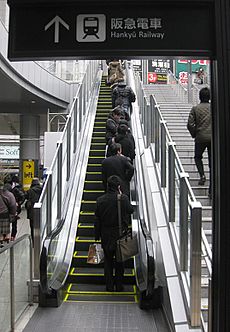
In many countries, there's an unwritten rule about how to stand on escalators. People who want to stand still usually keep to one side, allowing others to walk past them on the other side.
- In places like Canada, Germany, Hong Kong, the United Kingdom, and the United States, people usually stand on the right and walk on the left.
- In Australia and New Zealand, it's often the opposite: stand on the left, walk on the right.
- In Japan, it can even differ by city! In Osaka, people stand on the right, but in Tokyo, they stand on the left.
However, in some very busy places, like certain metro stations in Tokyo and Prague, people are encouraged to stand on both sides. This helps prevent uneven wear on the escalator and keeps the flow of people smooth during busy times.
Images for kids
-
One of the longest and fastest Soviet-era escalators in Europe, at Náměstí Míru station in Prague.
See also
 In Spanish: Escalera mecánica para niños
In Spanish: Escalera mecánica para niños


